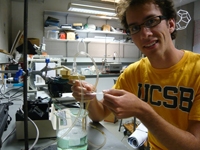
University:
Major:
Site Abroad:
Mentor(s):
Faculty Sponsor(s):
Project Title:
Project Description:
Microbubbles have long been observed to have unique physical characteristics, such as spontaneous ordering, and because of this they model metallic structures at an atomic scale accurately and efficiently. For the upcoming research and production of nanowires and nanotubes, it is important to know how spheres pack within a cylindrical boundary condition. The recent advances in x-ray tomography have allowed us to image bubble samples, in our case bubbles packed within cylinders, and approximate the system as spheres with given centerpositions and diameters. This data was used to numerically reconstruct each column of bubbles, omitting the outer, visible layer of bubbles to better see the internal structure. Unexpectedly, from a top view of each column we see not only a ring of centerpositions near the cylinder surface, but distinct inner rings as well. This result contradicts the belief in a random packing arrangement within the ordered boundary. Phyllotactic plots, 2D plots displaying the bubble centerpositions as if they were on a surface of an artificial cylinder but unrolled, were created for each ring, completely characterizing the arrangements. The volume fraction of each bubble column was also compared to numerical approximations for any given ratio of cylinder diameter to bubble diameter, showing structure agreement and a prediction of the volume fraction for larger cylinders. Further research is needed to better understand the relationship between successive bubble layers.
